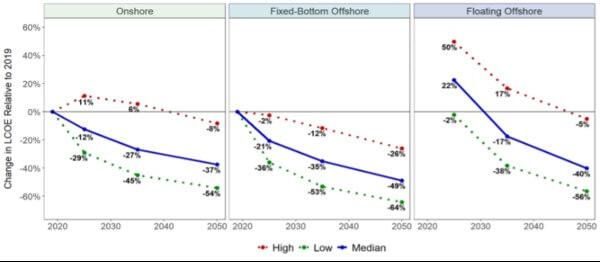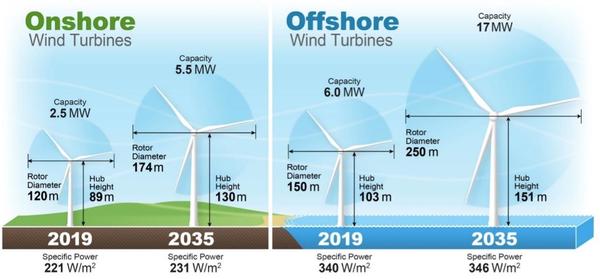Experts Predict Accelerating Cost Reductions in Offshore Wind
Wind energy experts, in a study by researchers at Lawrence Berkeley National Laboratory along with Erin Baker of the University of Massachusetts Amherst, predict significant reductions in the cost of wind energy by 2050, according to new research published today in the journal Nature Energy.
Baker and the Berkeley Lab surveyed the world’s foremost wind energy experts, who said that technological and commercial advancements are expected to drive down costs significantly. They predict wind energy costs will decrease 17 to 35 percent by 2035 and 37 to 49 percent by 2050, under a median or ‘best guess’ scenario. The experts anticipate that these reductions will be driven by bigger and more efficient turbines, lower capital and operating costs, and other advancements will create cost reductions in wind energy production.
Baker is the associate dean for research and graduate affairs in the College of Engineering, and a professor in industrial engineering and operations research. She also is the director of the Wind Energy Fellows program and faculty director of The Energy Transition Initiative at UMass. She brought her expertise in the method of expert elicitation, a structured method to elicit subjective probability distributions from experts, to the research. She also helped structure the questions that the survey team asked so that they were rigorous and helped interpret the results.
Five years after a similar effort, the new study summarizes a global survey of 140 wind experts. It uncovers insights on the possible magnitude of and drivers for cost reductions, anticipated technology trends, and grid-system value-enhancement measures. It focuses on three wind applications: onshore (land-based) wind, fixed-bottom offshore wind, and floating offshore wind.
“With prices coming down so rapidly, it is time to get serious about the offshore industry in the U.S.,” Baker said. “The Biden administration is taking great strides in this direction, by coordinating and fast-tracking the federal approval process. If states and local jurisdictions follow suit, we can get steel in the water and take advantage of the lowering costs to start fighting climate change.”
“Wind has experienced accelerated cost reductions in recent years, both onshore and offshore, making previous cost forecasts obsolete. The energy sector needs a current assessment,” said Ryan Wiser, senior scientist at Berkeley Lab. “Our ‘expert elicitation’ survey complements other methods for evaluating cost-reduction potential by shedding light on how cost reductions might be realized and by clarifying the important uncertainties in these estimates.”
Under a “best guess” (or median) scenario, experts anticipate 17%–35% reductions in the levelized cost of energy by 2035 and 37%–49% reductions by 2050 across the three wind applications studied, relative to 2019 baseline values (Figure 1). There are greater absolute reductions (and more uncertainty) in the levelized cost of energy for offshore wind compared with onshore wind, and a narrowing gap between fixed-bottom and floating offshore wind. Experts now anticipate 2050 onshore and offshore costs that are half what was predicted just five years ago, in 2015.
Notwithstanding the maturing of both onshore and offshore wind, there is substantial room for improvement, and costs could be even lower: experts predict a 10% chance that reductions will be 38%–53% by 2035 and 54%–64% by 2050 (Figure 2, ‘low cost’ scenario). At the same time, there is uncertainty in these projections, illustrated by the range in expert views and by the ‘high cost’ scenario in which cost reductions are relatively modest.

Figure 2: Estimated change in levelized costs across all three scenarios. Note: costs for floating offshore wind are compared to a 2019 baseline for fixed-bottom.
There are five key factors that impact the levelized cost of energy: up-front capital cost, ongoing operating costs, capacity factor, project design life, and cost of financing. Experts anticipate continued improvements across all dimensions, with the relative contribution varying by wind application. “Forecasts that only consider improvements in capital cost will, at best, capture about 45% of the cost reduction opportunity,” noted study co-author Joe Rand, also of Berkeley Lab.
A key driver in these improvements is turbine size, according to experts. For onshore wind, growth is expected not only in generator ratings (to 5.5 MW on average in 2035, up from 2.5 MW in 2019) but also in two factors that increase capacity factors—rotor diameters and hub heights (Figure 3). Offshore wind turbines are expected to get even bigger, 17 MW on average in 2035 (up from 6 MW in 2019). Floating offshore wind is anticipated to gain market share, accounting for up to 25% of new offshore projects by 2035.
Wind energy has grown rapidly, but its long-term contribution to energy supply depends—in part—on future costs and value. The new study finds that cost reductions have accelerated in recent years: faster than previously predicted by most forecasters, and faster than historical rates of decline. Experts anticipate future reductions and growing use of value-enhancement measures, both for onshore wind and offshore wind.

Figure 3: Anticipated growth in onshore and offshore turbine size.
“All else equal, these trends will enable wind to play a larger role in global energy supply than previously thought while facilitating energy-sector decarbonization,” concludes co-author Joachim Seel. “Analysts, investors, planners, and policymakers should avoid outdated assumptions and forecasts.” At the same time, as documented in the study, uncertainties in the magnitude of future cost reduction are significant, illustrating the importance of embedding uncertainty considerations in modeling and in policy, planning, investment, and research decisions.
The study was led by Berkeley Lab, and included contributions from the National Renewable Energy Laboratory, the U.S. Department of Energy, the University of Massachusetts Amherst, and scores of other advisors. The survey was conducted under the auspices of the IEA Wind Technology Collaboration Programme (www.ieawind.org). Berkeley Lab’s contributions were funded by the U.S. Department of Energy’s Office of Energy Efficiency and Renewable Energy.
- Source:
- UMass Amherst
- Author:
- Press Office
- Link:
- www.umass.edu/...
- Keywords:
- research, Lawrence Berkeley National Laboratory, UMass Amherst, cost reduction, offshore, onshore, decline, journal, experts, survey, turbine, efficiency, opertion























